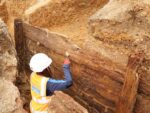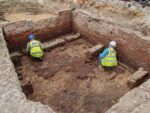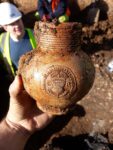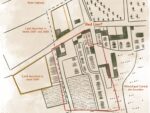 Archaeologists have discovered remains of London’s earliest purpose-built theater. The site at 85 Stepney Way was being excavated in advance of development when the team discovered a rectangular timber structure 40 by 31 feet made of 144 timbers. There were postholes around it, likely left by the structural posts that sustained the gallery seating. The dimensions of the structure and the evidence of the galleries closely matches the precise descriptions of the Red Lion playhouse found in two surviving legal records from a lawsuit filed by the carpenters who built it.
Archaeologists have discovered remains of London’s earliest purpose-built theater. The site at 85 Stepney Way was being excavated in advance of development when the team discovered a rectangular timber structure 40 by 31 feet made of 144 timbers. There were postholes around it, likely left by the structural posts that sustained the gallery seating. The dimensions of the structure and the evidence of the galleries closely matches the precise descriptions of the Red Lion playhouse found in two surviving legal records from a lawsuit filed by the carpenters who built it.
The Red Lion was originally a farmhouse built in about 1500. Within a few decades it had developed into a sort of speakeasy, an unofficial drinking establishment. In 1567, John Brayne made a deal with the farm owner to build the Red Lion playhouse next to the pub. It was London’s first dedicated public theater — as opposed to a home or inn or fair where theatrical productions were staged on occasion — since Roman times.
 Concessions must have been a big money-maker even back then, because ten years after he built the Red Lion, John Brayne and his brother-in-law, actor John Burbage, would go on to build The Theater in Shoreditch, the playhouse where Shakespeare’s plays were first staged. It was built on the site of St John the Baptist Priory and Brayne converted its former alehouse into a tap house for the theater.
Concessions must have been a big money-maker even back then, because ten years after he built the Red Lion, John Brayne and his brother-in-law, actor John Burbage, would go on to build The Theater in Shoreditch, the playhouse where Shakespeare’s plays were first staged. It was built on the site of St John the Baptist Priory and Brayne converted its former alehouse into a tap house for the theater.
 After The Theater was constructed, the Red Lion appears to have no longer staged plays. The farmer found another use for the space: a dog-fighting venue. Archaeologists have an unearthed a sad testament to this activity: the bones of dozens of dogs, some with bite marks to their skulls and legs severe enough to be fatal. The teeth of many of the dogs had been filed down, a despicable practice that continues today in dog fighting.
After The Theater was constructed, the Red Lion appears to have no longer staged plays. The farmer found another use for the space: a dog-fighting venue. Archaeologists have an unearthed a sad testament to this activity: the bones of dozens of dogs, some with bite marks to their skulls and legs severe enough to be fatal. The teeth of many of the dogs had been filed down, a despicable practice that continues today in dog fighting.
In Tudor London, theatres were politically and culturally ultra-controversial ventures. Indeed, they could only be built outside the jurisdiction of the City of London – partly because the extreme Protestant puritans who often ran the City considered theatres to be “an offence to the godly”, a “hindrance to the Gospel” – and schools “for all wickedness and vice”. Theatre-goers were seen as “the worst sort” of “evil and disordered people” who skipped work “to mis-spend their time”.
In a sentiment that resonates with our own times, they also thought that crowded theatrical events were plague infection risks.
As far as is known, most or possibly all of the plays performed at the Red Lion have been lost. That is partly because many plays in Tudor times were never published in printed form. Indeed the Red Lion’s opening drama – The Story of Samson (playwright unknown) – was almost certainly never printed, possibly because London’s monopoly printing organisation (a guild known as the Stationers Company) refused to print it, potentially on the grounds that a religious topic was being over-visually portrayed.
Indeed, they had extraordinary legal powers of censorship and could even seize unsuitable publications and haul their unfortunate authors before the ecclesiastical courts.
 The site was disturbed when a warehouse was built on in the 1960s, but all around the thick concrete foundation (13×10 feet) significant archaeological remains have survived. The only specifically theatre-related artifacts are large quantities of green-glazed ceramic fragments from the characteristic money boxes used to collect the price of a ticket and then smashed at the end of the performance to divvy up the spoils among the company.
The site was disturbed when a warehouse was built on in the 1960s, but all around the thick concrete foundation (13×10 feet) significant archaeological remains have survived. The only specifically theatre-related artifacts are large quantities of green-glazed ceramic fragments from the characteristic money boxes used to collect the price of a ticket and then smashed at the end of the performance to divvy up the spoils among the company.
It’s difficult to believe that Roman London had no purpose-built theater.
Read the second paragraph.
There was an amphitheater, were certainly a lot of drama was executed :skull:
Beneath Guildhall Yard and its surrounding buildings. Its extent and general ground plan can be discerned from its effect on the topography of this city area, in particular streets from the 10th and 11th centuries have obviously been routed to around it.
In the 16th century, the execution theaters were a lot more improvised, and there were no lions.